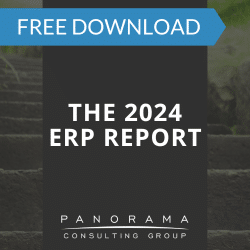For today’s CEOs, selecting an ERP system that enhances operational efficiency while empowering employees isn’t just a goal—it’s a necessity.
User experience (UX) in ERP design has become a pivotal factor in software selection. A user-centered approach can increase employee satisfaction and foster successful adoption.
Today, we’re exploring the role that ERP user experience should play in the software selection process. We’ll look at current ERP usability trends, the value of user-friendly ERP features, and how these elements impact business outcomes.
The Importance of ERP User Experience: Beyond Basic Functionality
Organizations often evaluate ERP systems based on functionality, features, and alignment with business processes. However, focusing solely on capabilities without considering how employees interact with the software can lead to the selection of an inflexible, cumbersome tool.
Our ERP selection consultants always tell clients to focus on user experience. In other words, it’s critical to ensure the chosen software is intuitive, user-friendly, and tailored to users’ requirements.
Here’s why ERP usability matters:
1. Employee Productivity and Error Reduction
When ERP interfaces are intuitive, employees spend less time navigating through menus and more time focusing on their core responsibilities. A well-designed ERP can streamline data entry and provide easily digestible analytics, reducing errors and freeing employees from repetitive tasks. Conversely, a poorly designed interface can increase error rates, necessitate additional training, and slow down workflows.
The 2025 Top 10 ERP Systems Report
What vendors are you considering for your ERP implementation? This list is a helpful starting point.
2. Change Management
Employee-friendly ERP systems facilitate user adoption and reduce resistance. When employees find the system easy to learn and use, they are more likely to participate in training and integrate the ERP into their daily work. In this way, simplified UX is a powerful change management facilitator – your organizational change management strategy becomes much more effective when the ERP is working with users instead of against them.
For example, a manufacturing company might implement an ERP system with easy-to-navigate production and inventory modules. This would allow floor managers and operators to update inventory levels and production schedules without extensive training or intricate processes. As a result, change management would become less about convincing employees to accept a new tool and more about enabling them to work more efficiently with it.
3. Employee Satisfaction and Reduced Turnover
ERP systems are, in many cases, the essence of an employee’s work experience. Complex, hard-to-use systems can lead to frustration, reducing job satisfaction and even prompting employees to jump ship. Conversely, when employees feel empowered by their tools, they are more likely to stay engaged and focused on their work.
User-centered ERP design enables employees to perform their tasks more effectively, communicate seamlessly across departments, and make more data-driven decisions. This boosts engagement and strengthens employees’ sense of value within the organization.
Key Features of an Employee-Friendly ERP System
Selecting a user-friendly ERP system isn’t just about evaluating surface-level design. It requires a deep understanding of how employees interact with the software daily. Here are some essential features to prioritize in a user-centered ERP selection:
1. Simplified, Role-Based Dashboards
A hallmark of user-centered ERP systems is customizable, role-specific dashboards. These dashboards offer tailored information relevant to each user’s role, eliminating the need to sift through irrelevant data and ensuring that each user can focus on their primary responsibilities. By keeping interfaces concise and relevant, a role-based design enhances both efficiency and user satisfaction.
2. Mobile Accessibility and Remote Compatibility
As remote work continues to reshape the modern workforce, mobile accessibility has become a non-negotiable feature for ERP platforms. Employees should be able to access essential data, approve workflows, and complete tasks from any location. User-friendly ERP features include seamless access across devices and mobile-optimized interfaces that retain the usability of their desktop counterparts.
3. Self-Service Features and Personalized Training Modules
Self-service features like quick access to FAQs, user-specific training guides, and contextual help buttons can reduce bottlenecks and increase employee confidence. In addition, personalized training modules within the ERP can reduce the learning curve and allow users to find answers to their questions without IT support. This mitigates common frustrations associated with system onboarding, making employees more confident and self-sufficient in their ERP usage.
4. Streamlined Data Entry and Automation Tools
User-centered ERP systems streamline data entry and automate many other routine tasks. Automation tools, such as auto-fill functions and drag-and-drop data entry, can make information capture quick and error-free. Similarly, workflows and machine learning algorithms can streamline mundane tasks, freeing up employees to focus on more rewarding work.
In both these cases, system integration is essential.
For example, an ERP system that seamlessly integrates with customer relationship management (CRM) tools and payroll systems allows users to access and update all relevant information in a single interface. This simplifies information capture while streamlining tasks, like updating client records and processing payroll adjustments.
5. Clear, Actionable Analytics and Real-Time Insights
The value of an ERP isn’t just in the data it collects, but in the insights it provides. Modern, user-friendly ERP systems present analytics in a way that’s easy to interpret and immediately actionable. With highly-visual real-time dashboards, employees across all levels can make informed decisions quickly.
For example, a local government might implement an ERP system that presents user-friendly insights regarding tax revenue, public service budgets, and community feedback. This would allow users to assess financial health and make budget adjustments quickly without deep technical knowledge.
ERP Usability Trends to Watch
1. AI-Powered Personalization
Artificial intelligence and machine learning are revolutionizing ERP interfaces by personalizing user experiences based on individual habits and preferences. Through predictive analytics, artificial intelligence (AI) can identify the features and data most relevant to each user, optimizing their interface over time. By proactively adapting to users’ needs, AI-driven personalization promises to make ERP systems more intuitive and effective.
2. Voice-Activated Interfaces and Conversational AI
With advancements in voice recognition technology, ERP vendors are exploring voice-activated interfaces as a way to enhance user experience. Voice-driven ERP systems enable employees to retrieve data, make updates, and manage workflows without traditional input methods. At the same time, conversational AI features, like chatbots, can assist users in navigating the system and answering routine queries.
For example, a supply chain management system integrated with an ERP, might feature conversational AI that responds to voice commands from warehouse staff checking stock levels or locating specific items. This hands-free accessibility is particularly useful In industries where hands-free access is crucial, such as logistics or field services.
3. Increased Focus on Cybersecurity Usability
As cybersecurity threats evolve, ERP systems need increasingly robust security features. However, an overly complex security process can diminish user experience. Current trends emphasize balancing strong cybersecurity measures with user convenience, incorporating features like single sign-on (SSO) and biometric logins. This is making secure access easier and faster for end-users.
Strategic Considerations for Selecting a User-Centered ERP
For CEOs overseeing ERP selection, prioritizing user experience might feel like a secondary concern compared to functionality or cost. However, user-friendly ERP features can yield long-term dividends, driving higher adoption rates, minimizing resistance, and maximizing ROI. Here are key strategies for ensuring your ERP selection aligns with user-centered principles:
1. Conduct Extensive User Testing Prior to Implementation
User testing allows you to evaluate how well employees interact with the system in realistic conditions before committing to full implementation. This testing should involve employees from various departments and roles. Observing users during testing can highlight potential usability challenges, allowing you to address issues before the system goes live.
2. Leverage Independent ERP Consultants for a Balanced Perspective
The ERP selection process is complex, with every vendor promising the latest features and capabilities. Partnering with independent ERP consultants can help you cut through sales pitches and evaluate systems based on unbiased assessments. By focusing on your organization’s unique needs, an independent consultant can recommend an ERP that delivers both functionality and user-friendly features.
3. Evaluate the System’s Scalability and Flexibility
Ensure the ERP you select can accommodate future expansion and adapt to changing needs without compromising usability. Scalable, flexible ERP systems not only enable you to keep pace with growth but they maintain a user-friendly interface as new modules are added. This means employees don’t have to relearn navigation or adapt to a new layout every time the system scales.
Learn More About ERP Selection
User experience has emerged as a critical factor in ERP selection. By prioritizing ERP usability trends and user-friendly features, executives can create an environment that enhances productivity and supports employee retention.
While user-friendly ERP systems can come with higher upfront costs, the investment often pays off by reducing long-term training and support expenses. Additionally, by lowering turnover and minimizing the need for customization, a user-centered ERP can help balance the initial costs with significant long-term savings and a stronger ROI.
Contact our ERP software consultants to start your user-centered ERP selection process.













